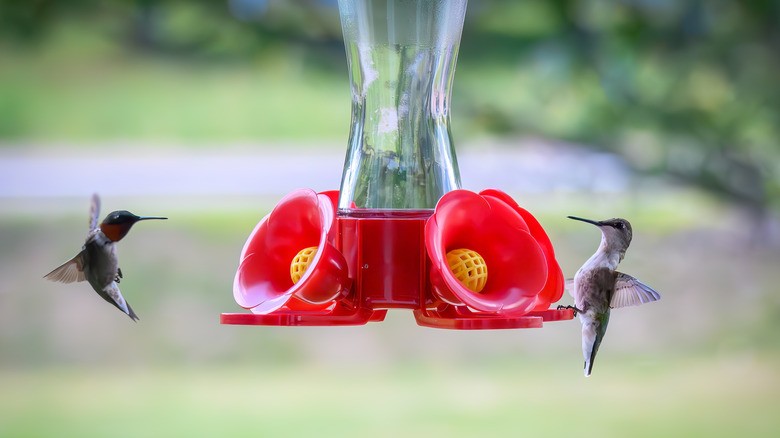Avoid This Hummingbird Feeder Mistake For More Visitors In The Garden
When you put up a hummingbird feeder, don't make a mistake that you'll really regret. If you don't wash your hummingbird feeder regularly, you could be risking serious illness for the hummingbird – or even death, which is probably the last thing you'd ever want to do! These sugary-filled feeders need to be washed more often than bird feeders offering seed. How often you clean them largely depends on the temperature outside.
During temperatures that hit 60 degrees Fahrenheit or less, you might only need to clean a feeder a couple of times a week. But if the thermometer reaches 90 degrees or higher, then it's important to clean the feeder every day. Why so often? The sugar water nectar inside a feeder can spoil easily. You'll even notice a sour, fermenting smell for any nectar that's been kept out too long. Sometimes, it may even get cloudy – a sign of mold. Murky nectar should always be changed right away. Moldy or spoiled nectar cause a host of potentially deadly diseases that can harm hummingbirds, ranging from candidiasis to salmonellosis.
Nectar might also get contaminated if other insects like ants feed from it. You can protect a hummingbird feeder from relentless ants with an easy DIY solution: Making your own ant moat from an old laundry cap. Not to mention, nectar gets sticky in hot weather, and it can wind up gunking up the holes of your feeder, which makes it harder for the hummingbirds to drink. You definitely don't wait for the nectar to run out before cleaning the hummingbird feeder.
How to properly clean your hummingbird feeder
So what is the proper way to clean a hummingbird feeder? While you can use soap, you should rinse well — these kinds of cleaners and detergents can be off-putting to birds. A simple paste made of baking soda and water can work. Baking soda happens to be a common kitchen ingredient that can give you a clean bird bath, as well.
Vinegar and water can also help sanitize your hummingbird feeder.. Just make sure you give it a very good rinse to ensure there's no vinegar left in the reservoir, as leftover traces of vinegar can burn a hummer's tongue. Always use white vinegar, and not apple cider vinegar, to clean. The apple cider varieties tend to be more mold-friendly. If you've got a glass feeder, you also can simply soak it in hot water to kill any bacteria inside. If you're really in a hurry, you can try throwing the hummingbird feeder in the top rack of the dishwasher.
Make sure to scrub the nectar reservoir well to remove any traces of mold so that it doesn't contaminate the new sugar water you plant to put in it. Don't forget the best feeder nectar is a concoction of ¼ cup white sugar and 1 cup water. Another cleaning tip? Hang your feeder in the shade on hot days to cut back on bacteria growth. If you're up for it, you can also try a clever aluminum foil hack to keep your hummingbird feeder cool in the heat.

